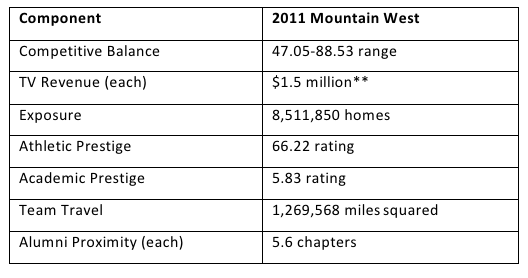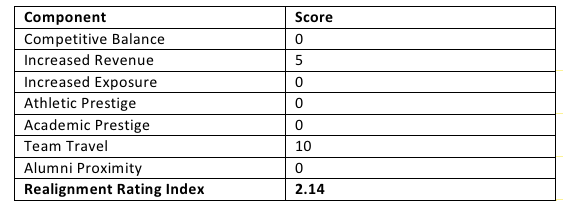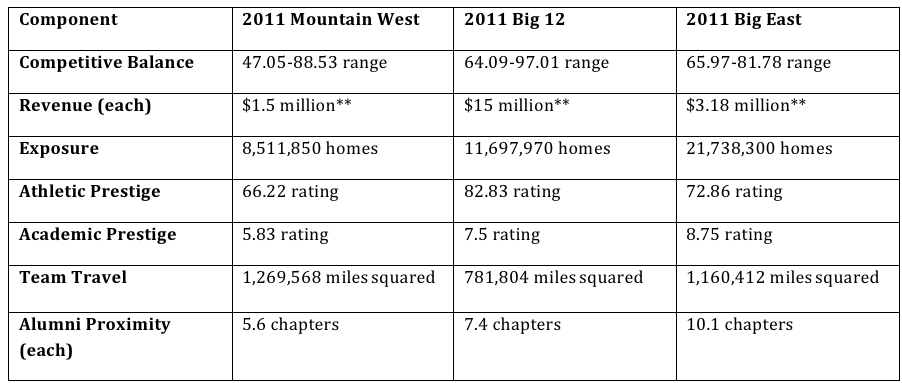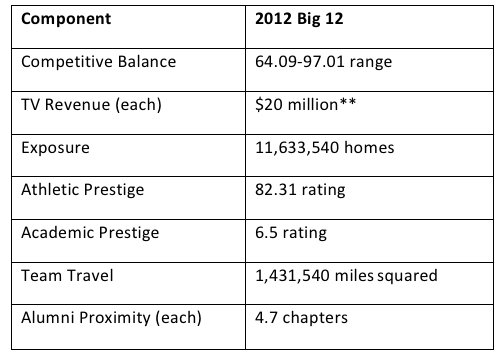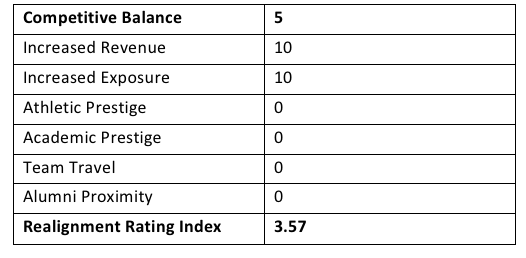By: G.K. Nwosu, Doctoral Student-University of Nevada Las Vegas
Conference realignment has arguably been the talk of intercollegiate athletics over the last two to three years. With the topic as ubiquitous as it has been, we found it an appropriate area for research and developed the Realignment Rating Index (RRI) as an instrument to measure several factors impacted by realignment at individual institutions, as well as their respective conferences. In The Realignment Rating Index: A New Lens for Assessing NCAA Conference Realignment, part one of a four-part analysis utilizing the RRI, we used football to help analyze the University of Colorado, the University of Utah, and the Pac-12 Conference. That piece also examined the University of Missouri, Texas A-&-M, and their new home conference, the SEC. In part two, we continue to employ the RRI to analyze the Mountain West Conference, the Big 12 Conference, and the effects of recent additions and defections.
With the Mountain West as the focus, we will analyze the conference in 2010 and then in 2011 with the addition of Boise State. For the Big 12, we will be studying the 2011 edition against the 2012 version, which essentially exchanged Mizzou and A-&-M for TCU and West Virginia University. In each case, we will be able to determine value gained or lost during the current era of conference realignment.
(For a detailed explanation of the RRI formula, refer to Part One of the series)
Realignment Rating Index Applied (Mountain West Conference)
With the departure of Utah and BYU from the Mountain West after the 2010 season, the conference was forced to replace two of its traditional power brokers. This came in the form of the Boise State Broncos. With the exception of the 2001 season, the Broncos played in a bowl game every year since 1999, including two BCS games. 1 The school moved to the Western Athletic Conference in 2001 and, in all but its inaugural season, won every conference crown until it departed for the Mountain West. 2 This disparity in competitive balance within the WAC, coupled with Boise’s rise on the national stage, made the school an attractive option to include in expansion during the 2010-2011 round of conference realignment. A synopsis of the Mountain West Conference at the conclusion of the 2010 football season is provided below in table-1.
Table 1-2010 Mountain West Conference
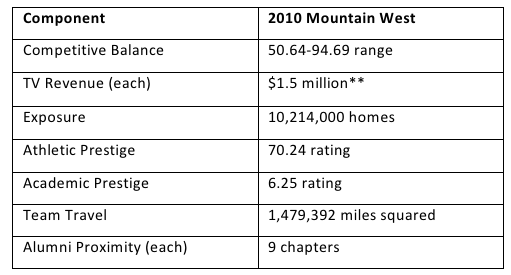 ** Estimate based on information compiled from conference data.
** Estimate based on information compiled from conference data.
The 2010 version of the Mountain West included Air Force, BYU, Colorado State, New Mexico, San Diego State, TCU, UNLV, Utah, and Wyoming. With the departure of the two Utah schools, a significant blow, the conference lost two of its top-five strongest programs as measured by Sagarin Ratings, approximately 1 to 2 million television viewing homes, 3 and a reduced alumni bridge to the state of California. The addition of Boise State was expected to assist in bolstering the conference’s viability and credibility. The Mountain West, with the addition of Boise State, is depicted below at the conclusion of the 2011 football season in table-2.`
Table 2-2011 Mountain West Conference
Boise State was the conference’s highest achiever in 2011 as measured by the Sagarin Rating. Revenue distributed to conference members, on average, stayed relatively the same, although there likely were caveats in the departing members’ exit agreement and Boise’s incoming agreement that may have altered each institution’s share of that revenue. Losing the Salt Lake City television market, ranked 32nd in 2010-11, could not be offset by the addition of Boise, the 112th television market. 4 The conference’s overall football performance dipped by approximately four points during the years of analysis, although the conference did benefit in that its geographic footprint, in terms of miles traveled, shrank. In losing BYU and Utah, the Mountain West lost two schools rated in the Carnegie Classifications as “high research” and “very-high research,” 5 respectively. Boise State is not intensive in doctoral research/education and did not receive a research classification. BYU claims 28 alumni chapters across the Mountain West with 15 of those based in California. Utah cites 8 alumni chapters across the research/education and did not receive a research classification. BYU claims 28 alumni chapters across the Mountain West with 15 of those based in California. Utah cites 8 alumni chapters across the conference with four in California. Boise’s lone Mountain West alumni chapter is based in California. The Mountain West Conference’s Realignment Rating Index score is presented in table-3.
Table 3- Mountain West Realignment Rating Index
Realignment Rating Index = CB+IR+IE +AthP+AcdP+Team+Alum / 7
The loss of the BYU and Utah had effects on the Mountain West Conference that could not be overcome even with the addition of an institution like Boise State, as illustrated by its RRI score of 2.14 ( Out of a possible 10. An RPI of 10 represents “positive” changes across all examined fields) . This may have ultimately led to the conference’s expansion to include Fresno State, Nevada, Hawaii, San Jose State, and Utah State, as well as the proposed merger with Conference-USA. The Mountain West will be losing Boise State and San Diego State to the Big East in 2013 and TCU left effective July 1 of this year. The Horned Frogs new home is the Big 12 Conference. The next section analyzes what the Big 12 has lost, gained, and can expect with the additions of TCU and West Virginia.
Realignment Rating Index Applied (Big 12 Conference)
Over the course of about two years, the Big 12 lost four of its founding members, was on the brink of dissolution, secured a new commissioner, and acquired two new institutions. For TCU, the move to the Big 12 is a homecoming of sorts, as it places the school back with many of its former Southwest Conference compatriots and rivals from the former Big 8 Conference. West Virginia rode the wave of Big East Conference dominance in recent years, winning or sharing the conference championship from 2003-2007, 2010, and 2011. 6 With uncertainty mounting in the Big East about its long term stability, TCU and West Virginia accepted invitations to join the Big 12 effective July 1 of this year. 7 Let’s take a look at the 2011 editions of each of the three conferences in play with this segment of realignment, depicted in table-4.
Table 4- 2011 Mountain West, Big 12, and Big East Conferences
A comparison of each conference in 2011 , coupled with the developing landscape of conference realignment, illustrates areas in which the Big 12 and its members can solidify or enhance their position through expansion. The table also illustrates what TCU and West Virginia potentially had to gain or lose by leaving their respective conferences for the Big 12. Because the table illustrates the landscape circa 2011, a baseline projection can be established for what TCU, West Virginia, and the rest of the conference can expect in 2012. A holistic projection of the new Big 12, is presented in table-5.
Table 5- 2012 Big 12 Projection
In adding TCU and West Virginia, the Big 12 was able to solidify its position as a power conference in college football. These additions helped to increase the conference’s exposure and television revenue through its agreement with ESPN and Fox Network. 8 Utilizing data from the 2011 Sagarin Rating, this year’s Big 12, as a conference, is projected to be weaker than last year’s. The Big 12 lost two institutions with top academic profiles, as both Missouri and A-&-M are designated as “very-high research” by the Carnegie Classifications. TCU is classified as not being intensive in research/education and West Virginia is classified as “high-research.” 9 The Big 12 Conference’s total RRI snapshot is presented in table-6.
Table 6-Big 12 Realignment Rating Index
The Big 12 improved in two components and remained the same in another. Under the Athletic Prestige Component, the conference dipped about half a point from 2011 to 2012. Because this variance was not significant, we ran the RRI again to award the Big 12 a “no change” score of five points. This resulted in the Big 12’s RRI score jumping slightly to 4.29. Overall the addition of the two institutions does not seem to offset the loss of Missouri and Texas A-&-M.
Conclusion
The Realignment Rating Index is designed to provide a snapshot of improvements and declines across components that are considered during conference realignment. As mentioned in part one of this series on conference realignment, RRI is best utilized in a longitudinal sense. The RRI may provide limitations in projections, as we cannot project how well a team will perform in the future. It does, however, provide a baseline to consider during realignment decisions. To recap, let’s take a look at how all four conferences analyzed ( In parts one and two of our series) thus far have scored using the RRI metric, as presented in table-7.
RRI Recap
Part three of this series on conference realignment will shift the focus back to the micro level as we analyze whether or not Boise State, Texas Christian, and West Virginia gained individually from their switches in affiliation.
G.K. Nwosu is a graduate of the University of Oklahoma ’10 where he studied Intercollegiate Athletic Administration master’s program. He is currently pursuing his doctorate at the University of Nevada Las Vegas in the Higher Education program where his focus remains Intercollegiate Athletic Administration, specifically sports organization behavior.
References:
- Boisestatefootball.com, The Program-Bowl History,Boisestatefootball.com (retrieved July 21, 2012), http://www.boisestatefootball.com/program/bowl-history. ↩
- Boisestatefootball.com, The Program-Standard of Excellence,Boisestatefootball.com (retrieved July 21, 2012), http://www.boisestatefootball.com/program/standard-excellence-0. ↩
- The Nielsen Company, Local Television Market Universe Estimates Comparisons of 2010-11 and 2011-12 Market Ranks (2012), http://www.nielsen.com/content/dam/corporate/us/en/public%20factsheets/tv/nielsen-2012-local-DMA-TV-penetration.pdf. ↩
- The Nielsen Company, Local Television Market Universe Estimates Comparisons of 2010-11 and 2011-12 Market Ranks (2012), http://www.nielsen.com/content/dam/corporate/us/en/public%20factsheets/tv/nielsen-2012-local-DMA-TV-penetration.pdf ↩
- Carnegie Classifications of Institutions of Higher Education. Carnegie Classifications, Carnegie Foundation for the Advancement of Teaching (retrieved July 17, 2012), http://classifications.carnegiefoundation.org/lookup_listings/institution.php. ↩
- WVUsports.com, 2012 West Virginia Mountaineer Football Prospectus, West Virginia University Department of Intercollegiate Athletics (retrieved July 23, 2012), http://issuu.com/wvusportspub/docs/2012-fball-prospectus. ↩
- Wendell Barnhouse, TCU, West Virginia Officially Join Big 12, Big12sports.com (July 1, 2012), http://www.big12sports.com/ViewArticle.dbml?SPSID=106137&SPID=13138&DB_LANG=C&DB_OEM_ID=10410&ATCLID=205499646. ↩
- ESPN.com News Services, Texas move helps Big 12 survive, ESPN.com (June 15, 2010), http://sports.espn.go.com http://sports.espn.go.com/ncaa/news/story?id=5286672/ncaa/news/story?id=5286672. ↩
- Carnegie Classifications of Institutions of Higher Education. Carnegie Classifications, Carnegie Foundation for the Advancement of Teaching (retrieved July 17, 2012), http://classifications.carnegiefoundation.org/lookup_listings/institution.php. ↩


